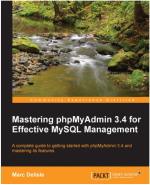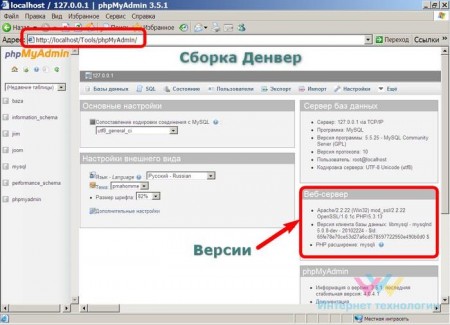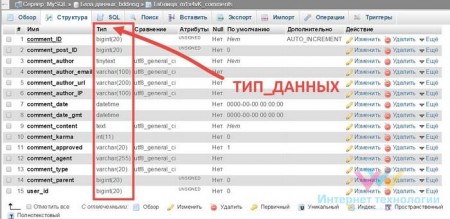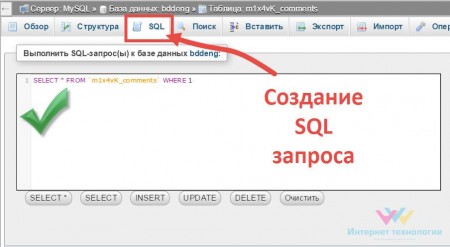Http localhost phpmyadmin sql php
phpMyAdmin Bringing MySQL to the web
About
phpMyAdmin is a free software tool written in PHP, intended to handle the administration of MySQL over the Web. phpMyAdmin supports a wide range of operations on MySQL and MariaDB. Frequently used operations (managing databases, tables, columns, relations, indexes, users, permissions, etc) can be performed via the user interface, while you still have the ability to directly execute any SQL statement.

phpMyAdmin comes with a wide range of documentation and users are welcome to update our wiki pages to share ideas and howtos for various operations. The phpMyAdmin team will try to help you if you face any problem; you can use a variety of support channels to get help.
phpMyAdmin is also very deeply documented in a book written by one of the developers – Mastering phpMyAdmin for Effective MySQL Management, which is available in English and Spanish.
To ease usage to a wide range of people, phpMyAdmin is being translated into 72 languages and supports both LTR and RTL languages.
phpMyAdmin is a mature project with a stable and flexible code base; you can find out more about the project and its history and the awards it earned. When the project turned 15, we published a celebration page.
The phpMyAdmin project is a member of Software Freedom Conservancy. SFC is a not-for-profit organization that helps promote, improve, develop, and defend Free, Libre, and Open Source Software (FLOSS) projects.
PhpMyAdmin на локальном сервере
Что такое PhpMyAdmin
PhpMyAdmin это скрипт для создания панели управления базами данных MySQL из браузера. Скрипт phpMyAdmin написан на языке PHP. Устанавливается скрипт в набор локального сервера, вместе с PHP интерпретатором и СУБД MySQL.
PhpMyAdmin, PHP и MySQL работают в связке и поэтому важно соответствие версий всей троицы.
Примечание: В этой статье мы рассматриваем работу с phpMyAdmin на локальном сервере, то есть в рамках индивидуального компьютера с установленными наборами WAMP или LAMP.
Вход в phpMyAdmin на локальном сервере
На готовых сборках локальных серверов типа XAMPP, Денвер, OpenSrevers пользователь БД задан в настройках и, как правило, это, пользователь [root] с пустым паролем. Если сборка WAMP делается самостоятельно, то пользователь БД задается специально и совпадает с пользователем MySQL, также заданного вами.
Форма авторизации в phpmyAdmin
Для входа в панель phpMyAdmin на локальном сервере запускаем программу phpMyAdmin из адресной строки. Запуск phpMyAdmin осуществляется следующим образом.
Если Вы собирали сервер самостоятельно, и правильно выставили все настройки для запуска phpMyAdmin в адресную строку, пишем:
localhost/phpmyadmin или httр:// www.test.ru/pma,
На сборке Денвер:
На сборке Open Server:
httр:// localhost/openserver/phpmyadmin/index.php или «Дополнительно>>>PhpMyAdmin», на флаге Open Server в трее Windows.
На сборке XAMPP, в панели управления ищем кнопку MySQL.
Вспомним что такое база данных
База данных это информация, упорядоченная в таблицах. Таблица очень удобный вид хранения информации, позволяющей хранить сотни и миллионы записей. Хранение организовано так, что в любое время информацию можно найти.
Самые используемые базы данных:
MySQL (наиболее подходит для работы с интерпретатором PHP),
Построены они на базе реляционной модели данных.
Примечание: Базу данных без изменения структуры и содержания можно переносить с одной платформы на другую.
СУБД MySQL
СУБД MySQL это система управления реляционными базами данных. Таблицы реляционных БД — двухмерные массивы данных составленные из столбцов (поля или атрибуты) и строк (записи или кортежи). Пересечение строки и столбца образуют ячейку БД. Ячейка БД это одно значение, а не группа значений.
Правила устройства БД в PhpMyAdmin на локальном сервере
Данные вставляемые в столбец, имеют уникальный ТИП_ДАННЫХ.
Наиболее распространённые следующие типы данных:
Язык базы данных в PhpMyAdmin на локальном сервере
Главный язык реляционных баз данных язык SQL. На нем пишутся запросы к базе данных. Называются запросы — SQL запрос. Для отправления SQL запросов в phpMyAdmin есть вклада: SQL, в верхнем горизонтальном меню.
Это все, про phpMyAdmin на локальном сервере. В следующей статье, я подробно расскажу, как работать с базой данных в phpMyAdmin.
localhost/phpmyadmin
http://localhost/phpmyadmin is a part of localhost database administration software (phpmyadmin) url login address. You can enter the address from http://localhost/phpmyadmin or you can use the following terminal input tool (web-based viewer).
CREATING DATABASE IN PMA
CREATING TABLES IN PHPMYADMIN
There are no tables under a newly created database. Once you have created the database, it will be ready to create the tables that will contain the information to be stored under the StartupDB database. The most important thing to know about table creation is that it can be stored and misuse of storage space.
We can store the name, surname, e-mail and gender information from a form on a web page. To create a table named users, you can use the table name in Pma and the number 5 in the row of the field number the first tablon is created.
In the page that comes up on the screen, the properties that will be included in the 5 adtes field will be specified in the username table to be created. We will create 5 properties of the information to be stored in the field. In the user table we will create, we store four different information such as first name, last name, email and gender. The aim is to give a sequence number to each name and lineage so that it is easy to access the information later. The name of the first field is given by typing in the userid line of the first information field on the screen. The userid field is chosen to store a number in the INT for a number hold only of a user. By selecting the auto_increment feature from the Extra menu, each row inserted into the database is autotomatically created to create its own userid value.
Then, for the field where the web name information is stored, the name of the field name is selected as Varchar. On the same line, the length / set section is entered with! & As the maximum number of letters that the name information can take. Similarly, for the surname field, the field name and surname are set to varchar and the value 16 is entered. The e-mail addresses are stored in the Varchar field and the Length / Set field in the e-mail address field. If an email address contains more letters, the first 50 letters will be stored.
A specific field type is selected in the field where tabloda gender information will be stored. If desired, this field may be preferred as varchar as well as name, surname and e-mail information, but Enum type is more useful in terms of performance and storage characteristics. In order to prepare the field for storage of gender information, ‘g’ in the field name, ‘e’, ’k’ in Lenght / Set section is selected by selecting Enum in the type line. The letters e and k in single quotes represent male and female genders.
When the Save key is pressed to create a table, a message is displayed on the screen indicating that the user table has been created, and SQL commands are required to create the same table. The same table can then be reconstructed using the following commands:
Code:
CREATE TABLE users (kullaniciid INT NOT NULL AUTO_INCREMENT, name VARCHAR (16) NOT NULL, name VARCHAR (16) not null, VARCHAR email (50) not null, gender ENUM ( ‘e’, ‘k’) not null, PRIMARY KEY (userid))
BROWSING AND MODIFYING TABLES IN PMA
After selecting the database name from the left menu that needs to be done to browse the databases via Pma or PHP, click on the Browse button next to the table name. If you want to browse the stored information in the user table that was previously entered as trial information, you can click on the Browse link and all the entered information can be displayed on the screen. There is a record entered on each line. The Edit and Delete bindings on the same row of these records are used in order to change and delete the information of that record. It is enough to click the Delete link to delete the record from the table. Click the Edit link to change the information for a contact.
SELECTION OF SOME INFORMATION IN THE TABLES IN PMA
If there are dozens of tables, it can sometimes be difficult to browse all of the areas together. Some areas that provide a certain condition have the Select property to be registered in Pma. After selecting the database name from the menu on the left side, the Select link next to each table name gives the user the ability to select some fields and list them according to a binary criterion. When the Select link is clicked, the topmost information box has the field names of the table. All or some of these names are selected by holding down the Control key and clicking. Then enter the desired criteria in the field name and Value lines at the bottom of the page. For example, in the previously created user table, the letter k is written on the gender line to select records with gender female, k. By clicking the Go button on the screen,
In some cases, it may be necessary to search for records that contain only a certain syllable. For example, you may need to search for users whose last name is suffixed.
In this case, the% sign is used in the operating system just like * wildcard in file searches. For records that begin with syllables as syllables, the% is written in the% syllable field for% records for all traversed syllables, and% syllabus for concurrent records. %% core% core% and% core layers.
BACKUP AND DELETE DATABASE IN PMA
Pma, with its powerful management features, allows you to retrieve the backup of the database in the system and to delete the databases. Selecting a database name from the left menu brings up a number of options for getting a backup of the database underneath the table names. Structure only, located under the View dump (schema) of database line, ensures that the database is backed up only as empty tables. It is useful when you need to move the ready-made database skeleton to another location, without having to retrieve the random entries in a database.
The Structure and data option is used to move all tables and fields in the database, along with the records within them, to another location. Once these options are selected, the Go key is pressed to populate the SQL backup screen required to move the records in the database to another database. To save the SQL backup to a file, select the Send option and press the Go button.
In cases where the database needs to be deleted, the Drop database link on the same screen should be used. When this link is clicked, the user will be prompted to delete the database. Drop operation should be used with caution, since the table in the database will cause all records to be deleted so that they can not be used again.
USING SQL COMMAND IN PMA
Pma allows master database users to use SQL. In the main page where the database information is located, the text in the center can be executed by writing the required SQL commands in the input field of the information. When SQL commands are entered incorrectly, MYSQL error messages can be displayed to the user via Pma. When it is desired to delete data using SQL, Pma will ask the user for confirmation to prevent data being erased as a result of an incorrect operation. Previously prepared SQL statements can also be called from an external file using the Browse key under the SQL run text field.
Using Pma it is possible to load database backups directly into the empty database using this feature.
The most important part we came up with!
Categories in the Table
Как развернуть phpPgAdmin и phpMyAdmin на Windows
Ни одно приложение и BI система на данный момент не может существовать без базы данных, наиболее популярными по крайней мере из бесплатных СУБД являются MySQL и PostgreSQL.
Конечно любой СУБД вполне можно управлять из командной строки без какого либо графического интерфейса, в этом есть и свои преимущества, к примеру если вы работаете с СУБД из командной строки то вам не потребуется установки какого либо дополнительного программного обеспечения для администрирования базы данных с любого ПК. Но всё же командная строка далеко не самый удобный в работе инструмент.
Также к перечисленным выше базам данных есть декстопные клиенты, к MySQL это Workbench, к PostgreSQL это PgAdmin, для установки этого программного обеспечения вам не понадобиться никаких дополнительных навыков, ставяться они как обычная декстопная программа. Я по большому счёту предпочитаю использовать именно эти клиенты. Дополнительным преимущественном десктопных СУБД клиентов являются то что они являются толстыми клиентами, т.е. вся обработка данных происходит на вашем ПК, а не на сервере, при этом скорее всего ваши запросы будут выполняться дольше, но нагрузка на сервер даже в случае многопользовательского режима будет минимальной.
Но всё же наибольшую популярность в работе с СУБД получили веб клиенты, такие как phpMyAdmin, и его аналог для PostgreSQL phpPgAdmin, в этой статье пойдёт речь о том как развернуть их на локальном ПК.
Разворачиваем phpMyAdmin на windows.
Ничего сложного в этом нет, дело в том, что за вас все необходимые манипуляции сделает WAMP.
Информация из википедии: WAMP — акроним от «Windows, Apache, MySQL и PHP». Данным сокращением описывается комплектация пакетов программ, под соответствующую ОС, обозначаемую первой буквой. Происходит от LAMP, где первая буква означает Linux.
Всё что вам потребуется перейдя по этой ссылке скачать и установить WAMP Server.
Далее необходимо запустить сервер. ярлык для этого находится в папке, в которую вы установили WAMP (при установке 64 битной версии по умолчанию путь к папке c://wamp64), и называется wampmanager.exe.
Если всё прошло успешно после этого вы можете открыть браузер, ввести http://localhost/phpmyadmin и пользоваться phpMyAdmin.
Разворачиваем phpPgAdmin на windows.
Далее если помимо MySQL вы планируете использовать PostgreSQL выполните следующие действия. В данном случае все дальнейшие инструкции выполняются после установки WAMP сервера.
На самом деле менять настройку extra_login_security не рекомендуется, лучше создать для phpPgAdmin дополнительного пользователя и заходить под ним.
Настраиваем автозапуск WAMP сервера при загрузке Windows.
Последний штрих это настройка автоматического запуска WAMP сервера при старте операционной системы, через обычную автозагрузку сделать это не получится поэтому выполните следующие действия:
Далее перезагрузите ПК, и можно пользоваться, всем что мы в этой статье установили.
Работа в phpMyAdmin
Прежде чем описать работу в phpMyAdmin, мы расскажем, что такое SQL и для чего создавалась MySQL.
Что такое SQL и зачем он нужен
SQL (Structured Query Language) — структурированный язык запросов. Прототип этого языка появился после реляционной алгебры в конце 70-х годов. Его разработала компания IBM Research. Язык назывался SEQUEL, что расшифровывается как Structured English Query Language, но по мере развития слово «English» ушло из этого словосочетания. SQL — это «полный язык баз данных». Это значит, что он включает в себя:
Язык SQL используется для работы с реляционными базами данных. Реляционные базы данных — это базы с наборами данных, между которыми уже предопределены связи. Данные в них организованы в виде таблиц, эти таблицы состоят из строк и столбцов. В каждом столбце хранится свой тип данных, а в строках — наборы связанных значений, которые относятся к одному объекту или сущности.
Реляционная система управления базами данных (РСУБД) – система управления реляционными базами данных. Самая известная РСУБД – MySQL. Пользователь взаимодействует с ней на языке SQL, посылая запросы к базе данных. Чтобы было удобно работать с этой базой данных, на языке PHP было написано веб-приложение с графическим интерфейсом. Оно получило название phpMyAdmin.
Как войти в phpMyAdmin
Чтобы узнать, как запустить phpMyAdmin, войдите в панель управления хостингом и следуйте соответствующей инструкции:
В разделе «Главное» выберите пункт меню Базы данных. Кликните по названию базы данных, которую хотите открыть в phpMyAdmin, и нажмите Перейти:
В разделе «Базы данных» выберите phpMyAdmin:
phpMyadmin, вход MySQL
Перейдите в раздел «Базы данных». Выберите нужную базу данных и кликните phpMyAdmin:
Как узнать пароль базы данных
Логин и пароль от базы данных можно увидеть в конфигурационном файле сайта.
Информация о конфигурационных файлах, хранящих настройки подключения к базам данных популярных CMS. Если вашей CMS нет в списке или ваш сайт создан без использования CMS, обратитесь к разработчику сайта или на тематические форумы.
Доступ в phpMyAdmin по прямой ссылке в ISPmanager и Plesk
В ISPmanager и Plesk присутствует возможность доступа в phpMyAdmin по прямой ссылке (cPanel такой функционал отсутствует). Это удобно, когда необходимо дать доступ разработчикам сайта. Ссылка для входа в phpMyAdmin выглядит следующим образом:
ISPmanager: https://serverXX.hosting.reg.ru/phpmyadmin/, где serverXX.hosting.reg.ru — адрес сервера хостинга, его можно узнать в статье Пароли для доступа к хостингу.
Plesk: https://splX.hosting.reg.ru:8443/phpmyadmin, где splX.hosting.reg.ru:8443 — адрес сервера хостинга, его можно узнать в статье Пароли для доступа к хостингу
База данных u1234567_default
Для подключения к phpMyAdmin вы можете использовать уже созданную базу данных u1234567_default (где u1234567 — ваш логин хостинга), которая автоматически создаётся при заказе хостинга. Реквизиты доступа к данной БД приведены в статье Пароли для доступа к хостингу.
Внимание База данных u1234567_default создаётся только при заказе тарифных планов от «Host-0» и выше. Если вы заказывали тарифный план «Host-Lite», а потом повысили его до более высокого, данная БД не создаётся. Вам необходимо создать БД самостоятельно по инструкции: Как создать базу данных MySQL
Не могу войти в phpMyAdmin
Чтобы зайти в phpMyAdmin, необходимо использовать логин и пароль пользователя базы данных. Не путайте логин и пароль пользователя базы данных с логином и паролем от услуги хостинга (u1234567).
Если пароль базы данных не подходит, вы можете изменить его на новый при помощи инструкции: Как изменить пароль базы данных?
Как создать, удалить или изменить таблицу в базе данных phpMyAdmin
Внимание! Редактирование базы данных может привести к некорректной работе вашего сайта. Перед внесением изменений создайте бэкап вашего сайта или обратитесь к разработчикам.
Нажмите по необходимой базе данных:
Внизу страницы в блоке «Создать таблицу» введите Имя новой таблицы, количество столбцов и нажмите ОК:
Укажите данные для создания таблицы:
Localhost, phpMyAdmin, как зайти





